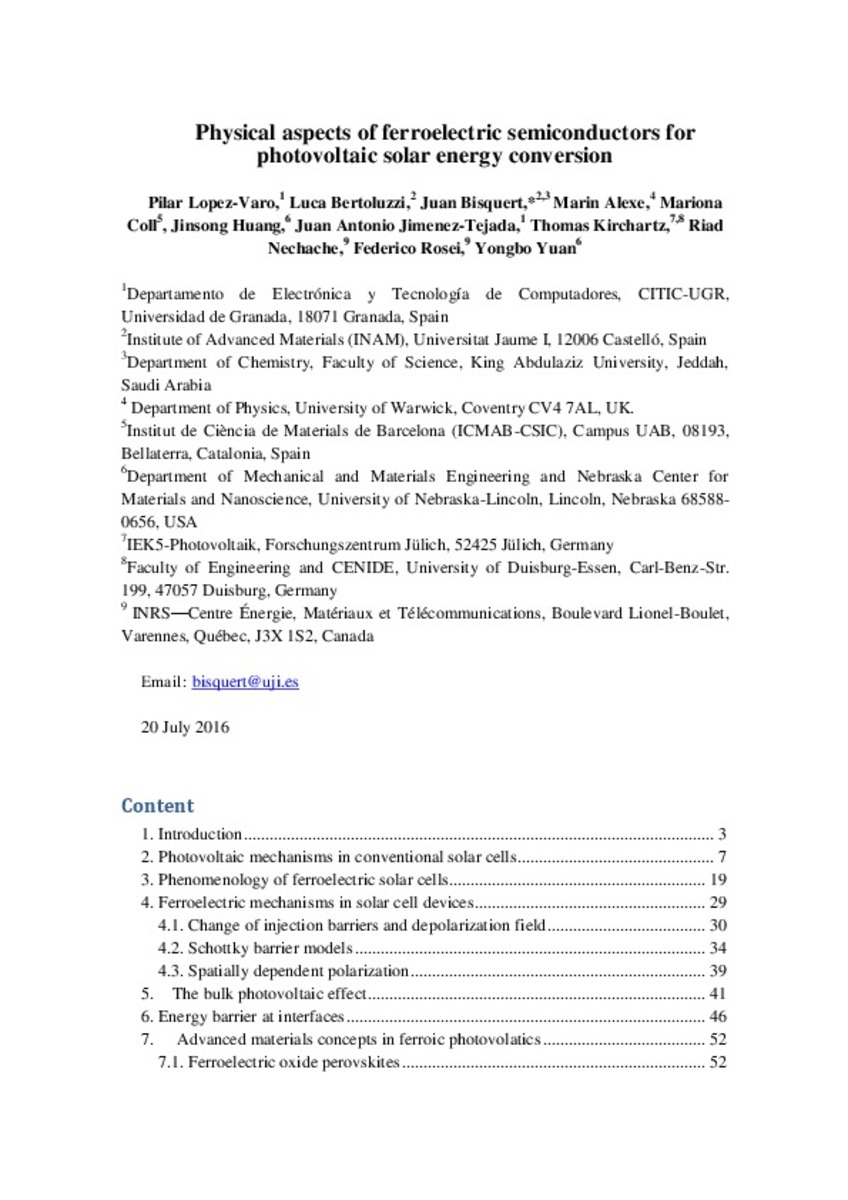Mostrar el registro sencillo del ítem
Physical aspects of ferroelectric semiconductors for photovoltaic solar energy conversion
| dc.contributor.author | Lopez-Varo, Pilar | |
| dc.contributor.author | Bertoluzzi, Luca | |
| dc.contributor.author | Bisquert, Juan | |
| dc.contributor.author | Alexe, Marin | |
| dc.contributor.author | Coll, Mariona | |
| dc.contributor.author | Huang, Jinsong | |
| dc.contributor.author | Jiménez Tejada, Juan Antonio | |
| dc.contributor.author | Kirchartz, Thomas | |
| dc.contributor.author | Nechache, Riad | |
| dc.contributor.author | Rosei, Federico | |
| dc.contributor.author | Yuan, Yongbo | |
| dc.date.accessioned | 2016-11-03T10:47:06Z | |
| dc.date.available | 2016-11-03T10:47:06Z | |
| dc.date.issued | 2016-10 | |
| dc.identifier.citation | LOPEZ-VARO, Pilar, et al. Physical aspects of ferroelectric semiconductors for photovoltaic solar energy conversion. Physics Reports, 2016, vol. 653, p. 1-40. | ca_CA |
| dc.identifier.uri | http://hdl.handle.net/10234/163998 | |
| dc.description.abstract | Solar energy conversion using semiconductors to fabricate photovoltaic devices relies on efficient light absorption, charge separation of electron–hole pair carriers or excitons, and fast transport and charge extraction to counter recombination processes. Ferroelectric materials are able to host a permanent electrical polarization which provides control over electrical field distribution in bulk and interfacial regions. In this review, we provide a critical overview of the physical principles and mechanisms of solar energy conversion using ferroelectric semiconductors and contact layers, as well as the main achievements reported so far. In a ferroelectric semiconductor film with ideal contacts, the polarization charge would be totally screened by the metal layers and no charge collection field would exist. However, real materials show a depolarization field, smooth termination of polarization, and interfacial energy barriers that do provide the control of interface and bulk electric field by switchable spontaneous polarization. We explore different phenomena as the polarization-modulated Schottky-like barriers at metal/ferroelectric interfaces, depolarization fields, vacancy migration, and the switchable rectifying behavior of ferroelectric thin films. Using a basic physical model of a solar cell, our analysis provides a general picture of the influence of ferroelectric effects on the actual power conversion efficiency of the solar cell device, and we are able to assess whether these effects or their combinations are beneficial or counterproductive. We describe in detail the bulk photovoltaic effect and the contact layers that modify the built-in field and the charge injection and separation in bulk heterojunction organic cells as well as in photocatalytic and water splitting devices. We also review the dominant families of ferroelectric materials that have been most extensively investigated and have provided the best photovoltaic performance. | ca_CA |
| dc.description.sponsorShip | The research leading to these results has received funding from the European Union Seventh Framework Program [FP7/2007–2013] under grant agreement 316494 and from MINECO of Spain under project TEC2013-47283-R and Grant FPU12/02712. F.R. acknowledges funding and partial salary support for work on multiferroic materials from NSERC, through an EWR Steacie Memorial Fellowship. | ca_CA |
| dc.format.extent | 39 p. | ca_CA |
| dc.format.mimetype | application/pdf | ca_CA |
| dc.language.iso | eng | ca_CA |
| dc.publisher | Elsevier | ca_CA |
| dc.relation.isPartOf | Physics Reports Volume 653, October 2016 | ca_CA |
| dc.rights | Copyright © 2016 Published by Elsevier B.V. All rights reserved. | ca_CA |
| dc.rights.uri | http://rightsstatements.org/vocab/InC/1.0/ | * |
| dc.subject | ferroelectric semiconductors | ca_CA |
| dc.subject | solar energy conversion | ca_CA |
| dc.subject | photovoltaic devices | ca_CA |
| dc.title | Physical aspects of ferroelectric semiconductors for photovoltaic solar energy conversion | ca_CA |
| dc.type | info:eu-repo/semantics/article | ca_CA |
| dc.identifier.doi | http://dx.doi.org/10.1016/j.physrep.2016.07.006 | |
| dc.rights.accessRights | info:eu-repo/semantics/openAccess | ca_CA |
| dc.relation.publisherVersion | http://www.sciencedirect.com/science/article/pii/S0370157316301946 | ca_CA |
| dc.type.version | info:eu-repo/semantics/submittedVersion |
Ficheros en el ítem
Este ítem aparece en la(s) siguiente(s) colección(ones)
-
FCA_Articles [501]
Articles de publicacions periódiques







